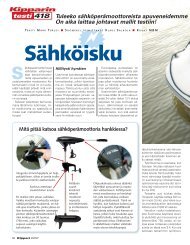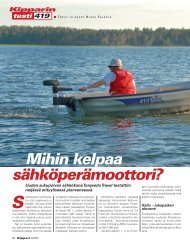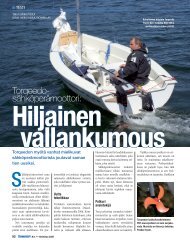1 2 3 - Torqeedo
1 2 3 - Torqeedo
1 2 3 - Torqeedo
Create successful ePaper yourself
Turn your PDF publications into a flip-book with our unique Google optimized e-Paper software.
Motor and power electronics<br />
Background information on electric motors<br />
There are four criteria for differentiating among electric motors: the frequency response, the generation of the alternating field<br />
(commutation), the excitation of the magnetic field, and the structural shape.<br />
Depending on the frequency response, we speak of:<br />
Induction motors: the ratio between the engine speed and the frequency of the supply voltage is not constant: it depends on<br />
the loading condition of the machine. The higher the load, the higher the speed difference – the so-called “slip”, i.e. a specified<br />
propeller speed is not maintained at higher flow resistances. Hence, thrust is not available at the very time it is required.<br />
Synchronous motors: with this type of motor, the ratio between the supply voltage frequency and the engine speed is constant.<br />
As a rule, synchronous engines are torque controlled. This means that they always draw as much power as they need in order<br />
to provide the necessary torque at the desired speed. For this reason, they are the preferred motor in areas with particularly<br />
demanding torque requirements. Should the motor require more power in order to maintain a specified propeller speed, the<br />
motor automatically draws more power.<br />
Depending on the type of the generation of the alternating field (commutation), we divide electric motors into:<br />
Mechanically-commutated motors: The brush-complemented motors generate the alternating field necessary for the motor to<br />
operate by means of sliding contacts. Based on their geometric organization, these “brushes” convert the power depending on<br />
the rotor position. A shortcoming in these motors is the wear-and-tear of the brushes, hence making the motors maintenanceintensive.<br />
The contact resistance also causes so-called brush losses, impairing the degree of effectiveness of the motor.<br />
Electronically-commutated motors: they generate the alternating field necessary for the motor to operate by means of an electronic<br />
circuit – the “frequency converter”. This prevents the occurrence of brush losses, and the motors are maintenance-free.<br />
The enormous progress that has been made in the area of electronic power components and circuit design has only made it<br />
possible in recent times for high-power motors to be manufactured at a marketable price.<br />
Depending on the type of generation of the magnetic field, electric motors are divided into<br />
Electromagnetic-excited motors: this type provides the necessary magnetic field by means of a second loading section. This<br />
makes this option more economical: however, it is considerably bulkier and heavier than the permanent magnet-excited motor.<br />
Further, it is also considerably less advantageous with regard to power consumption and degree of effectiveness.<br />
Permanent magnet-excited motors: in this case, the permanent magnets generate the necessary magnetic field. Hence, there are<br />
no performance losses in the field coils.<br />
Depending on the structural shape, we speak of:<br />
Internal rotor motor: in this classical model of electrical motor, the rotor is surrounded by the stator. The rotor is a revolving motor<br />
component attached to the motor shaft: it is also known as a “rotor motor” or “armature”. Since the coils of the internal rotor<br />
motor are located on the outside, the motor has advantages when it comes to cooling. Compared to other structural shapes,<br />
however, it is relatively low-torque.<br />
Disc armature motor: it generates the torque (= force times lever) by arranging the axle of the magnetic field parallel to the shaft<br />
instead of radial to the shaft. This enables the realization of geometries in which the location of the electromagnetic generation<br />
of power is a good distance from the axle. Hence, a higher torque is achieved at the same power. The disc armature geometry is<br />
disadvantageous to outboard motors with direct water cooling. Due to its extremely large diameter, it isn’t possible to build disc<br />
armature motors directly into a pylon.<br />
External rotor motor: this is the most modern type of motor: the coils are arranged inside. The rotating magnets are located on<br />
an externally-running bell. With the same structural shape, external rotor motors hence have a significantly higher torque than<br />
internal rotor motors.<br />
Catalogue 2007<br />
13









